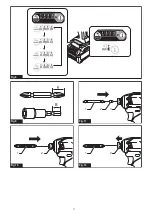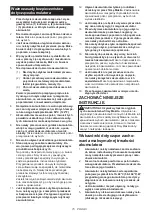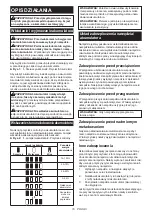
10 ENGLISH
Application mode
(Impact force grade
displayed on panel)
Maximum blows
Purpose
Example of application
1 (Soft)
1,400 min
-1
(/min)
Tightening with less force to avoid
screw thread breakage.
Tightening sash screws or small
screws such as M6.
T mode *
–
(The tool stops rotating
soon after impact starts.)
Driving self-drilling screws to a thin
metal plate with good finish.
Tightening self-drilling screws.
: The lamp is on.
*
When the tool rotates counterclockwise, the impact per minute is the same as in 4 (max) mode, 4,100 min
-1
(/min).
NOTE:
When using T mode, the timing to stop the driving varies depending on the type of the screw and material
to be driven. Make a test driving before using this mode.
NOTE:
When none of the lamp on the panel is lit, pull the switch trigger once before pressing the button or
button .
NOTE:
All lamps on the switch panel go out when the tool is turned off to save the battery power. The impact force
grade can be checked by pulling the switch trigger to the extent that the tool does not operate.
ASSEMBLY
CAUTION:
Always be sure that the tool is
switched off and the battery cartridge is removed
before carrying out any work on the tool.
Installing or removing driver bit/
socket bit
Use only driver bit/socket bit that has inserting portion
shown in the figure. Do not use any other driver bit/
socket bit.
►
Fig.9
For tool with shallow driver bit hole
A=12mm
B=9mm
Use only these types of driver
bits. Follow the procedure
1. (Note) Bit-piece is not
necessary.
For tool with deep driver bit hole
A=17mm
B=14mm
To install these types of driver
bits, follow the procedure 1.
A=12mm
B=9mm
To install these types of driver
bits, follow the procedure 2.
(Note) Bit-piece is necessary
for installing the bit.
Procedure 1
For tool with one-touch type sleeve
To install the driver bit, insert the driver bit into the
sleeve as far as it will go.
►
Fig.10:
1.
Driver bit
2.
Sleeve
Procedure 2
In addition to
Procedure 1
, insert the bit-piece into the
sleeve with its pointed end facing in.
►
Fig.11:
1.
Driver bit
2.
Bit-piece
3.
Sleeve
To remove the driver bit, pull the sleeve in the direction
of the arrow and pull the driver bit out.
►
Fig.12:
1.
Driver bit
2.
Sleeve
NOTE:
If the driver bit is not inserted deep enough into
the sleeve, the sleeve will not return to its original posi-
tion and the driver bit will not be secured. In this case, try
re-inserting the bit according to the instructions above.
NOTE:
When it is difficult to insert the driver bit, pull the
sleeve and insert it into the sleeve as far as it will go.
NOTE:
After inserting the driver bit, make sure that it
is firmly secured. If it comes out, do not use it.
Installing hook
WARNING:
Use the hanging/mounting parts
for their intended purposes only, e.g., hanging the
tool on a tool belt between jobs or work intervals.
WARNING:
Be careful not to overload the
hook as too much force or irregular overburden
may cause damages to the tool resulting in per
-
sonal injury.
CAUTION:
When installing the hook, always
secure it with the screw firmly.
If not, the hook
may come off from the tool and result in the personal
injury.
CAUTION:
Make sure to hang the tool
securely before releasing your hold.
Insufficient
or unbalanced hooking may cause falling off and you
may be injured.






































